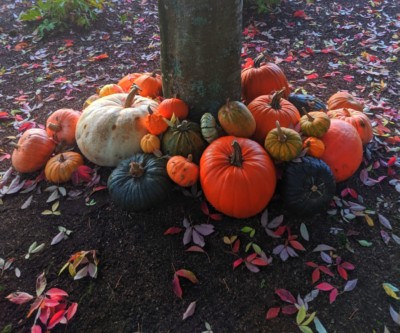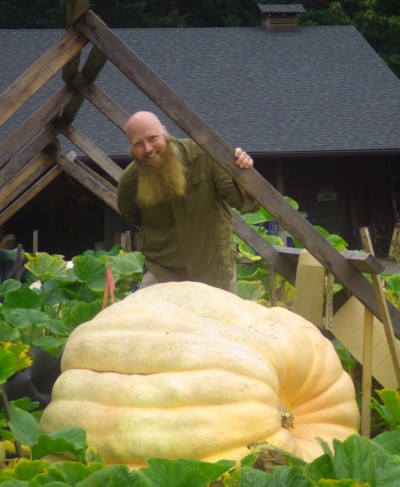The History of the Squash Hunt

A squash display at Bloedel Reserve
An Autumn Tradition Takes Shape
October brings an autumn tradition to Bloedel Reserve — the Squash Scavenger Hunt! Visitors young and old look forward to the fascinating array of gourds on display all around the grounds, all of which are grown specifically for this fanciful family-friendly activity.
This tradition began back in 2011 as the brainchild of Executive Director Ed Moydell. Initially, it was not structured as a scavenger hunt but began simply as a group of autumn displays placed around the Reserve. Director of Horticulture Andy Navage even enlisted the help of visitors’ children to direct the placement of the squash and pumpkins. What began as an experiment soon blossomed into a seasonal tradition. Now the Bloedel crew artistically curates the grouping and placement of the hundreds of specimens. When guests arrive, they receive a map that shows them where to “hunt” for the displays, along with questions intended to sharpen their powers of observation. On the back of the map, there is more information about the varieties of gourds that have been grown each year.
Inside, Outside, All Around the Grounds
From the beginning, all squash and pumpkins on display have been grown behind the scenes in Bloedel Reserve’s nursery area. Every year, we grow approximately 50 varieties of squash and pumpkin. Of those, on average about 30 varieties produce enough gourds for the hunt. Some varieties we know will be reliable producers, some are new varieties we want to try, and some come from seeds we have collected from the previous years’ squash to try again just for fun. Since all of the squash and pumpkin varieties are grown close together, the plants are what we call “open pollinated” and the seeds from the resulting gourds won’t necessarily produce true-to-type. This means the crew gets to enjoy the excitement of seeing what the collected “mystery seeds” will produce.

The biggest and the smallest varieties this year (2020)
The squash and pumpkin varieties we grow vary from very small to quite large. Last year (2020), two truly giant pumpkins — Dill’s Atlantic Giants” — were hard to miss. Each weighed in at nearly 1,000 pounds! This year, our largest varieties are weighing in at about 200 pounds apiece.
When the Super Squash Scavenger Hunt finishes at the end of October, the crew will collect seed for next year’s Squash Hunt. While fungi and wildlife take their toll on some of the gourds on display, the Bloedel staff and volunteers get to take home the remaining, intact edible survivors.

Philip Bloomquist, Gourd Guru
Meet the Gourd Guru
The person behind the gourds at Bloedel Reserve is Living Collections Manager Philip Bloomquist. Philip started working at Bloedel Reserve the year after the Squash Hunt first began, coming to the Reserve with two Bachelor’s degrees in horticulture and landscape architecture, as well as a farming background from his childhood. In his younger years, Philip participated in 4H and won several purple ribbons (the best ribbons in 4H) for vegetables he entered into competitions. Now, besides being an all-round plant genius, Philip is our “Gourd Guru.”
Philip’s approach to growing squash and pumpkins at Bloedel Reserve takes into account the climate of the Pacific Northwest. Hailing from warmer climates, gourds need long growing periods to reach maturity so being able to take advantage of as much of the available growing season is important. Philip starts squash and pumpkin seeds indoors in our greenhouses roughly between April 1st and 15th. The young plants are planted outside in mid-May. (In our climate, anyone who wants to “direct sow” seeds out of doors should generally wait until after May 1st, when our exterior soil temperatures have warmed up enough.)

The pumpkin bed in early spring
We heavily amend the soil in the growing beds with aged manure. Then we lay irrigation drip lines in 100 foot lengths spaced four feet apart. Finally, the soil and irrigation system is covered with black plastic. Though the plastic is not biodegradable, it is reusable. Besides keeping down weeds, the dark plastic helps us water efficiently by retaining moisture for the growing plants, and it soaks up heat from the sun to warm the soil, which the squash and pumpkins love. Every four years, we remove the plastic and add fresh manure to the soil. We have found that the manure and native soil seem to provide enough nutrients, so that no additional fertilizer is needed.
Slugs are the only significant pest problem on squash, especially for the young plants. Philip applies a slug deterrent, Sluggo, in the spring. Sluggo is a totally organic compound that kills both slugs and snails without the usual poisons. After use, it breaks down into harmless fertilizer (iron phosphate). Without it, the ghastly gastropods would bring a swift end to the squash displays at Bloedel Reserve.
SIGN UP FOR OUR ENEWSLETTER
Stay up to date on all of the events and activities taking place at Bloedel Reserve.

